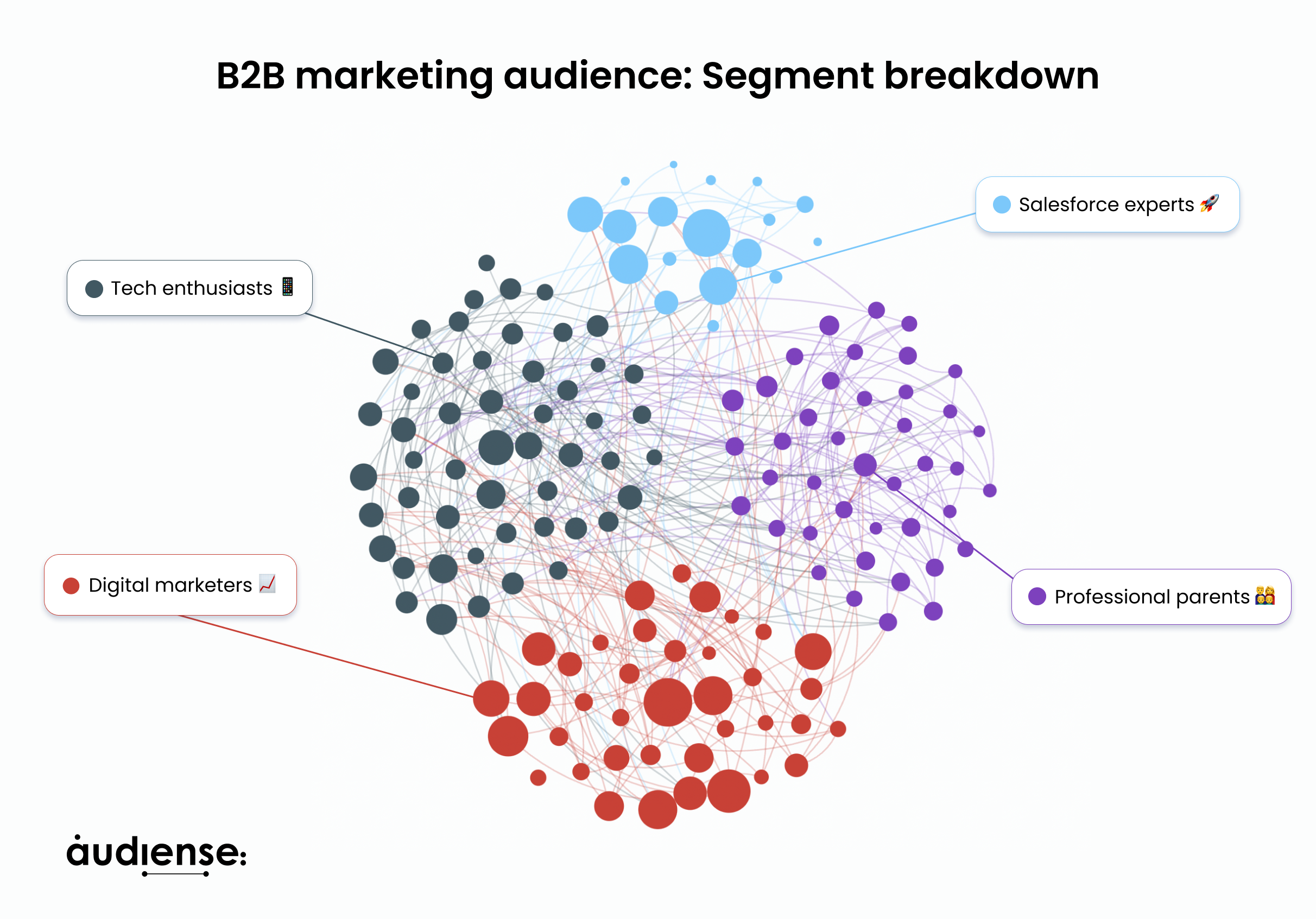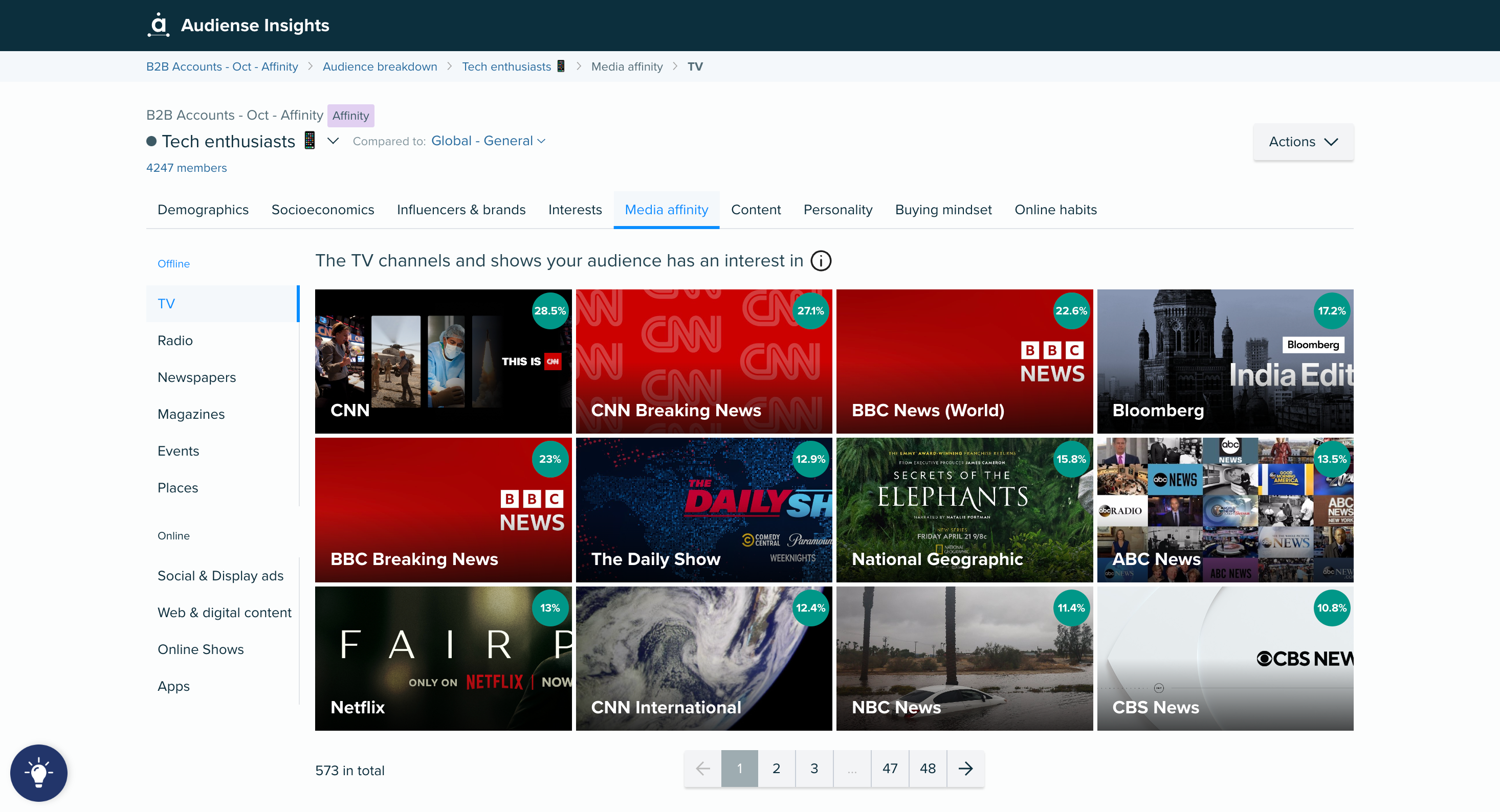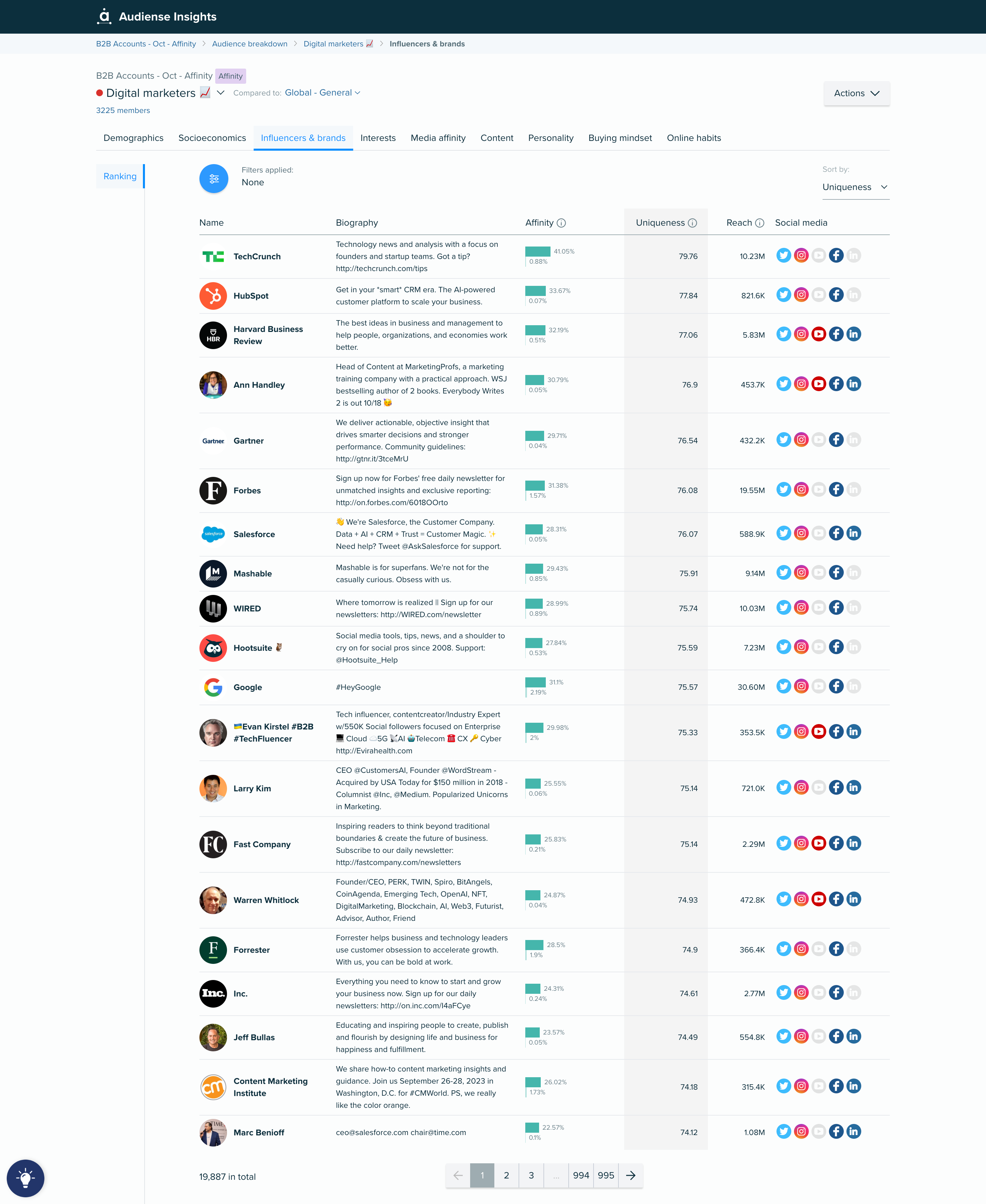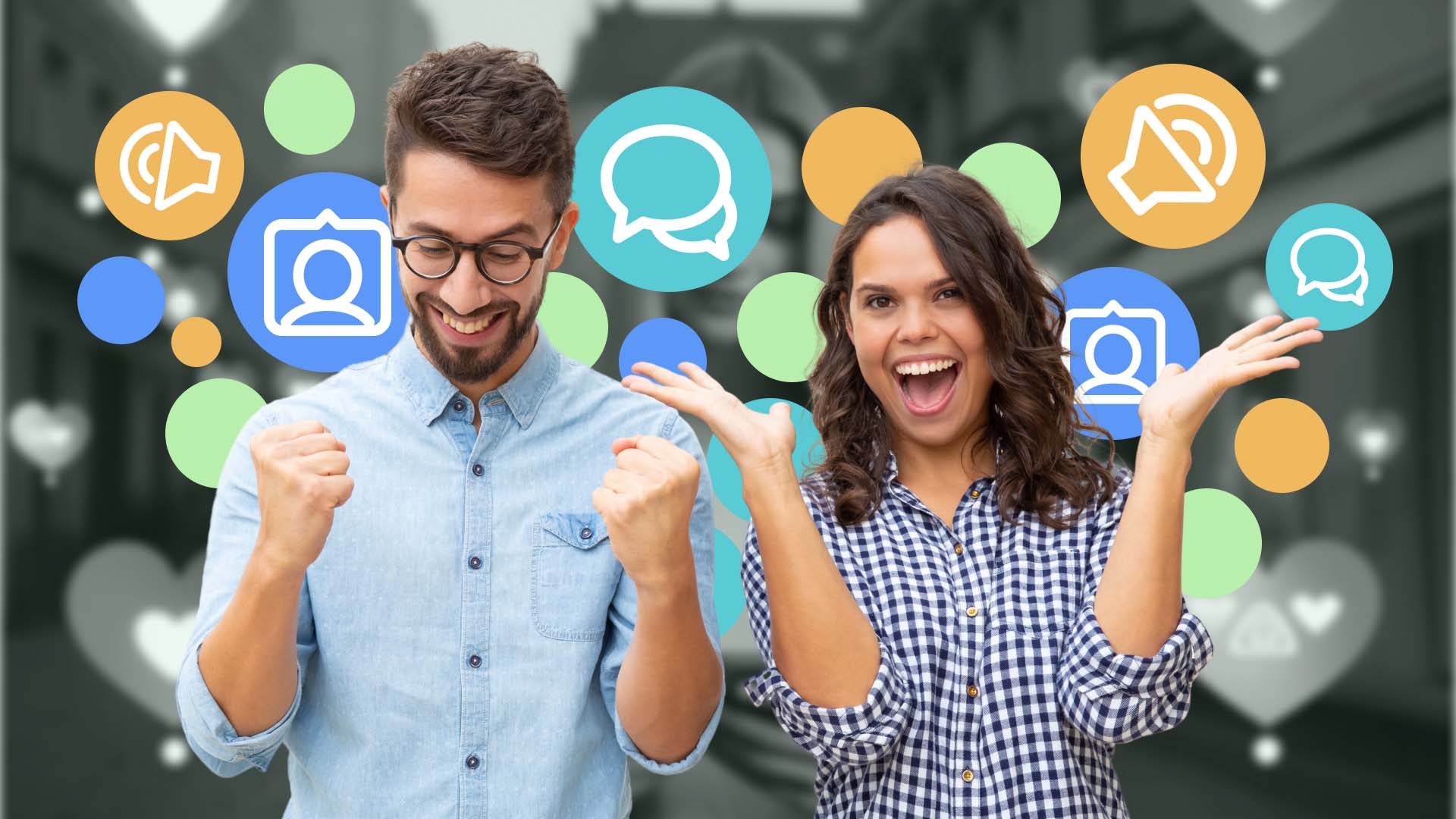Words have power: How influencer marketing can revitalize your B2B marketing strategy
Influencers are all the rage in B2C marketing. Supermodels selling underwear, TikTok stars pushing their favourite coffee brands, bloggers of all kinds promoting skincare, make-up and water bottles. If you’re a B2B brand, sometimes it can feel like you’re missing out on the hottest party of the century.
But influencer marketing can be just as valuable for B2B brands. Nothing is as powerful as word-of-mouth and at the end of the day, there are real people behind the gatekeepers, funnels and decision-making. Influencer marketing is about how you connect with them. Let’s look at the data:
- The global influencer market is estimated to be worth $21.1 billion, with B2B businesses earning approximately $5.20 for every dollar they spend on influencer marketing and an incredible 86% of B2B brands saying they’ve found success using influencer marketing as part of their wider strategy.
- Think about the kind of people you follow on LinkedIn – why do you follow them? 50% of B2B buyers say they rely on industry thought leaders to stay up to date on trends and developments in their field.
- 94% of marketers believe that influencer marketing is a successful strategy for B2B brands, and yet only 24% are using it in their overall business plan.
- That said, influencer marketing is on the rise. According to Hubspot, one in four marketers are currently using it and 17% of marketers were planning to invest for the first time in 2023.
- What kind of influencers are B2B brands partnering with? 77% say industry experts and analysts, 56% say internal executives, 48% say niche experts and 42% say employees. B2B influencers can come from all walks of life, who you choose seems to depend on your overarching goals.
If those stats aren’t persuasive enough, let’s talk about the benefits of influencer marketing.
B2B influencer marketing can help you reach new audiences, improve brand credibility and authority, drive new leads and allow you to leverage niche expertise that benefits your customers. Plus, there are so many ways you can engage. Webinars, blog content, podcasts… the opportunities for B2B brands are endless.
In this month’s spotlight, we’re all about B2B influencers. We’ll explore the potential audience for B2B brands, and we’ll review some five-star B2B marketing campaigns that made influencers work for them.
What does the B2B marketing audience look like?
The main purpose of B2B influencer marketing is to expand your reach to an entirely new audience, meaning there are thousands of different types of people you could potentially reach. Plus, the type of customer you could potentially reach will vary depending on your industry, your product, and existing influencers in the space.
To help build an understanding of what a potential B2B customer audience could look like, we focused our efforts on a smaller segment relevant to what we do. We ran an interconnectivity report that targeted people who have attended or talked about major B2B marketing events worldwide. Then, we decided to run an affinity report which clustered the audience into segments based on commonalities of affinity and interests they have expressed.
Looking at the audience as a whole, we can see that they’re split roughly 50/50 in terms of gender, with men making up slightly more of the audience at 54%. Of course, the locations of the events we targeted will affect our location data, but around 60% of our total audience are based in the US, 7% in India, 5% in the UK and 2% in Canada.
This audience tends to consist of mostly younger professionals, with 27% of them aged between 18 and 24 years old, and a further 22% aged 25 to 34. We can also see that they’re hugely engaged with their industries, with bio keywords including topics such as Salesforce, marketing, digital, tech and business.
While we can make general assumptions about what a B2B audience may look like, it’s always important to remember that your audience is not a monolith, particularly in a B2B setting when customers may have differing levels of influence or interests in their industry. Using the affinity report as a starting point, we’ve identified three key segments to delve deeper into.
Our fourth segment, Salesforce experts 🚀, is a very specific niche likely impacted by the data fueling our reports. But it’s still hugely valuable in terms of understanding what a focused B2B marketing segment may look like for your brand, so do take a look at the full report here.

Tech enthusiasts 📱
- United by their love of all things tech, this segment is at the forefront of new developments and most likely identify as those famed early adopters that marketers love so much!
- Brand names are a big deal for this segment, with 53% of customers likely to be influenced by a brand name when it comes to making purchase decisions. Interestingly, they’re also 30% more likely to use credit cards for their purchases than your average global consumer.
- While tech unites them, their interests are much broader. Sports and travel rank highly in their interests, and brands and influencers include industry titans such as Bill Gates and Elon Musk, as well as NASA, major politicians like Biden and Obama, and news outlets such as The New York Times, The Wall Street Journal and CNN.
- In a similar vein, this segment is widely engaged with a broad range of political and cultural perspectives, with media affinities showing CNN, Bloomberg, NPR, National Geographic, HuffPost and The Guardian as top sources of information.
- Looking at their personalities and habits, IBM Watson defines them as analytical and social. They’re intrigued by new ideas, and they want to bring about positive change. They’re 90 times more likely than your average person to be spending time on LinkedIn and 40 times more likely to be on Medium, suggesting they like to stay up to date with their industry and connect with like-minded people.

Professional parents 👨👩👦👦
- There’s more to life than work and this segment is busy finding balance between doing what you love and raising a family. To be clear, we’re not saying this is a segment containing parent bloggers and influencers, this is a segment that uses social media to grow their careers and enrich their personal lives.
- While we do see both men and women in this segment, it is undeniably skewed more toward women, who make up 75% of the total segment. We also see that ‘mom’ appears prominently in the bio keywords, alongside ‘wife’ and ‘family’.
- Looking to influencers and brands, we see a huge mix of household names and niche brands that cater to specific interests. Paypal, Walmart and Chipotle sit alongside DoorDash, Funko Pop and ColourPop cosmetics, providing a snapshot of their segment’s broad interests. Perhaps most striking is the massive influencer of Cash App, a mobile payment app that is hugely popular in the US.
- Unsurprisingly, 75% of this segment is more likely to be influenced by recommendations from friends and family. We also see social media and online advertising having significant influence over decisions, suggesting this segment may be open to well-placed influencers they identify with.
- How do you reach them? Looking at online habits, we see this audience spending much of their time on TikTok, Discord and Snapchat. We can also see they are significantly more likely to be browsing on mobile, which may impact the kind of content you choose to create.
Digital marketers 📈
- Next up, our digital marketers, who make up a quarter of the total audience size. This segment tends to be located in powerhouse urban centres such as San Francisco, Boston, Chicago, London and Paris, networking with other professionals and sharing their expertise.
- While 25% of this segment is made up of Gen Z professionals who have grown up with social media entering the industry, there’s also a generous chunk of people aged 35 to 44 years old that have been here from the very beginning (us included). Digital marketing trends may come and go, but these professionals have seen it all.
- Looking to influencers and brands, this segment is clearly tapped into all things B2B influencer marketing. Notable accounts include CMI, HubSpot, Forrester and multiple self-described influencers and thought leaders who use their social media bios to outline their interests and what they talk about. Special shoutout to our friend Rand Fishkin, co-founder of SparkToro!
- This segment is an incredible 300 times more likely to be using LinkedIn than your average person. Based on their online habits and their interests, it’s clear that this segment views social media as a place to network, be inspired by experts and thought leaders, and stay on the pulse of trends shaking up their industry.
- That said, they are more than just their jobs. We can also see a few other interests shining through, mostly music related. Recent content shared by this segment includes Beyonce’s #renaissanceworldtour, and they’re also spending time on media-rich networks such as Spotify, SoundCloud and TikTok.

5 examples of B2B brands winning at influencer marketing
1. Bosch Professional
Bish, bash, Bosch. A German company popular with consumers for their home appliances, Bosch also has a B2B arm of their company, Bosch Professional, which sells power tools to tradespeople. They’ve run a few notable campaigns over the years including Bosch Power Tools, which harnessed micro-influencers to create an effective YouTube campaign that used real reviews to reach their target audience.
But one of their most recent campaigns is a perfect example of how you can make B2B marketing fun… by keeping it human. #ReadyForAnything, which won the Best Use of Social Media category in The Drum B2B Awards 2022, firmly established Bosch Professional as the go-to brand for tradespeople.
In this playful campaign, Bosch put people at their heart of their strategy. They created a series of social media challenges designed to showcase just how robust their professional tools were, as well as highlighting how high-quality tools can make their customer’s lives (and jobs) much easier.
This Instagram-first influencer campaign recruited multiple influencers including a plumber, an electrician, a tiler and a carpenter to stir up inter-trade rivalry and get customers rallying behind their profession. This led to authentic content, with influencers competing in challenges and posting across Instagram, Facebook and YouTube.
This creative approach to B2B influencer marketing led to a 23% engagement reach (12% up on the target they originally had in mind), as well as a 14% increase in landing page visits and a 6% increase in sales for Bosch Professional’s durability range,
2. monday.com
2020 was a tricky time for companies around the world. Regulations around public spaces and safety forced everyone to pivot the way they worked, with many building an entirely new infrastructure from scratch to manage and support remote teams.
We know that this presented major opportunities for companies like Zoom, Slack and Microsoft, who quickly rolled out video conferencing software and chat tools. But what about managing multi-faceted projects that require regular updates and next level collaboration? Enter, monday.com.
Working closely with industry experts and influencers, including people like Shama Hyder, monday.com quickly rolled out educational resources that showed how companies can manage remote teams more effectively. This content relied on real insights and authentic opinions, helping monday.com build awareness of their project management software and drive more leads into their funnel.
This strategy in a time of uncertainty paid dividends. They were able to significantly expand their social reach, achieving over 17 million people with their influencer posts – an astonishing 1,790% above their initial target – and they had more than 300,000 organic impressions across their social media channels.
For top #productivity tips from #marketing and #design pros, explore our new resource: https://t.co/fsZ6fdiIrW
— monday.com (@mondaydotcom) June 24, 2020
Learn from@CarlaJohnson@shama@lisapatb@aaronorendorff@justcreative@dallisonlee@barrymoltz@mnthomas@juliaemccoy@melbourne__miss@angelatague@jayacunzo pic.twitter.com/O910vCsoQQ
3. American Express
A pioneer of influencer marketing across their B2B and B2C products, American Express tend to have multiple influencer campaigns running at once, with each strand geared toward different segments.
We particularly loved their Love My Store campaign. While this may have been launched in 2015, this campaign formed the foundation of their ongoing B2B campaigns and initiatives such as Small Business Saturday, Shop Small UK, and an entire resource centre dedicated to supporting small businesses.
Nominated as a finalist in the Shorty Awards, Love My Store was built around the results of an independent panel survey they commissioned to understand how their members were using their credit cards. This helped them draw beneficial links between retailers and customers, with 67% of AmEx customers saying they’d be more likely to make a purchase if they saw it would be accepted at a small business. So, AmEx set out to get more decals in shop windows.
They partnered with several influencers, including celebrity interior designer Emily Henderson, to create content that would encourage more business owners to purchase AmEx decals and advertise their acceptance of AmEx cards.
All of this work culminated in a photo competition on Twitter and Instagram, encouraging user-generated content in the form of storefronts sharing photos of their AmEx window decals using the hashtag #LoveMyStoreAmexContent for a chance to win a $10,000 storefront redesign plus a consultation with Henderson. Overall, the campaign drove 5 million impressions, 50,000 social engagements and led to direct sales of 400,000 Love My Store decals.
Key takeaways
As the sun sets on another industry spotlight, let’s take a moment to reflect on what we’ve learned about making B2B influencer marketing a success for your brand.
- Really, truly know your audience: You think B2B marketing, you think LinkedIn, right? Not always the best choice. As Bosch Professional proved, sometimes you need to expand your social networks to reach your ideal audience. Their tradespeople were more likely to be spending time on more informal channels, with Instagram top of mind, so they made this the focus of their B2B campaign. A winning approach that paid dividends and demonstrated a true understanding of their market.
- Go beyond vanity metrics: Follower counts are so early 2010s. To run a successful B2B influencer marketing campaign, you need a robust set of metrics that will truly reflect what you achieved. Engagement rates, landing page visits, and genuine sales all trump followers. This applies to the influencers you work with too, while 1 million followers look great on paper, how many of those 1 million followers are real people that will make a real purchase?
- Find the perfect balance between advocacy and experts: People buy from people. But people also don’t want to feel like they’re constantly being sold to, even if that message is coming from another real person. Consider the goals of your B2B influencer marketing campaign and use this to identify the kind of influencer you need to create authentic, engaging content. If you’re looking to start a conversation and educate customers, go for a thought leader or an expert. If you want to build awareness and credibility, an advocate may be the best route to market.
Ready to take the next step in audience intelligence for your marketing? With tools like Audiense, conducting in-depth audience analysis and discovering actionable takeaways makes creating tailored marketing strategies easier than ever.
P.S. If you want to learn more about industry marketing as a whole, check out our influencer marketing resources page which can teach you everything from how to find influencers to the differences between influencers and ambassadors. You might also enjoyed these 17 examples of B2B influencer campaigns.







